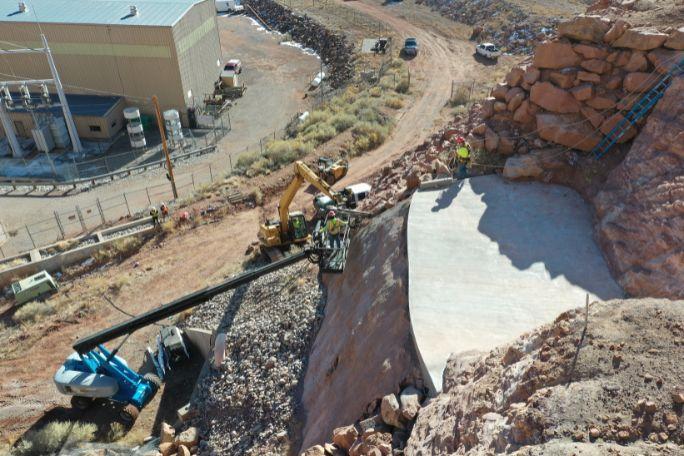Commercial construction has a significant impact on carbon emissions and can pollute the air and waterways.
Our industry can do better.
In this article, we’ll cover the negative impacts of construction. We don’t point out problems without providing solutions, though. Once you know how construction can impact the environment, we’ll take you through a number of methods that you can use (and that we’ve used) to make construction projects greener and more sustainable.
There’s a lot to cover—let’s build our knowledge:
The negative impacts of construction
The built environment accounts for 39% of worldwide carbon emissions. “Embodied carbon”—basically, CO2 emitted from the production of building materials—accounts for a significant portion of that 39%.
Commercial construction has a huge environmental footprint.
Waste generation
The EPA estimates that 600 million tons of waste were generated through construction & demolition in 2018—more than twice the amount generated by homes and businesses in the same year.
While most of this waste is generated through demolition, construction creates its share of waste, too. Materials can go unused if they’re flawed or if too many were ordered. Packaging materials must be discarded, and chemicals like paints can expire if there are delays in the construction process.
Resource consumption
Commercial construction consumes a staggering amount of resources, with buildings like skyscrapers being among the most resource-intensive to build. Lumber, glass, metal, concrete, and more are all consumed when buildings are constructed—in fact, concrete is the second most consumed resource on the planet (with water being the first).
Fuel is used to transport materials and operate machinery. Water is consumed to create concrete. Commercial construction is among the most resource-intensive activities on the planet.
Air pollution
As we’ve already discussed, construction is an important contributor to global CO2 emissions. C02 is released in the creation of cement—in fact, the cement industry is responsible for about 8% of the world’s carbon emissions. These emissions are caused by burning the fuel needed to create cement and by the chemical reaction that occurs when cement is created.
This embodied carbon is only part of the problem—as discussed above, transportation and heavy machinery also require fuel, which further contributes to CO2 emissions.
Water pollution
The materials used in construction can be carried by wind and rainwater into waterways. Sediment, chemicals, and trash can all end up in nearby bodies of water, harming aquatic life and rendering the water dangerous to humans, as well.
Sustainable construction
With calls for climate action growing louder, both the public and private sectors are incentivizing greener commercial construction. A number of new, green commercial construction tools and methods have been developed in response to these incentives. Let’s discuss three such options:
Pollution prevention measures
The first step is to take measures to reduce pollution. These measures can include:
- Using more fuel-efficient heavy equipment
- Sourcing materials from local companies
- Controlling dust with sprinklers and on-tool extraction
- Properly disposing of all waste, recycling where possible
- Covering all drains and treating wastewater
- Securing sand, cement, and sediment
These measures tackle both how pollution is generated and how those emissions are controlled. One of the best ways to eliminate pollution, however, is to use fewer materials and fuel. This can be accomplished by choosing to retrofit existing buildings rather than tearing them down and constructing new buildings.
Using sustainable materials
The materials used to construct the building play a key role in the project’s ability to meet sustainability goals.
Together with architects and engineers, construction companies can plan to use a number of different sustainable materials, including:
- Lumber from companies with sustainable forestry practices
- Reused materials, like masonry from deconstructed buildings
- Recycled (and recyclable) materials, like recycled steel and insulation made from recycled products
Eco-friendly materials can also play an important role in green commercial construction—windows, for example, can be built with low-E glass. Passive green design elements can also be chosen; for example, green roofs can be chosen over traditional roofing systems.
EPA Greenscapes program
This article has largely focused on the more obvious elements of the built environment—the buildings themselves. That’s not the only thing commercial construction companies and business owners should focus on, however.
Green landscaping practices are a crucial piece of the sustainability puzzle. The EPA Greenscapes program offers advice on how to lower landscaping costs, all while using more environmentally-friendly materials. Everything from aesthetics to drainage is impacted by landscaping—the Greenscapes program can help you make your landscape greener and more efficient.
Sustainable construction with Dub-L-EE
At Dub-L-EE Construction, we have a long track record of providing high-quality construction using sustainable, green methods. Looking to reduce your carbon footprint while building or renovating? Call Dub-L-EE.

Eddie has been a resident of Albuquerque his entire life.
After he graduated from high school, Eddie joined the Plumbers & Pipefitters Union where he obtained his Journeyman Plumber and Journeyman Gas Certifications. He then worked in the commercial plumbing industry for 7 years until he and his father decided to go into business together and started Dub-L-EE, LLC.
In the last 7 years Eddie has obtained his GA02, GA03, and MM98 certifications allowing Dub-L-EE to fully utilize Eddie Sr. and Eddie Jr.’s expertise in the construction industry.

